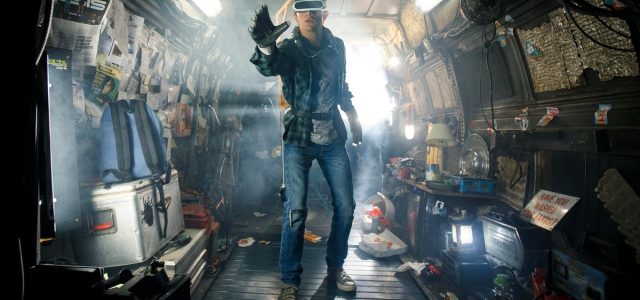


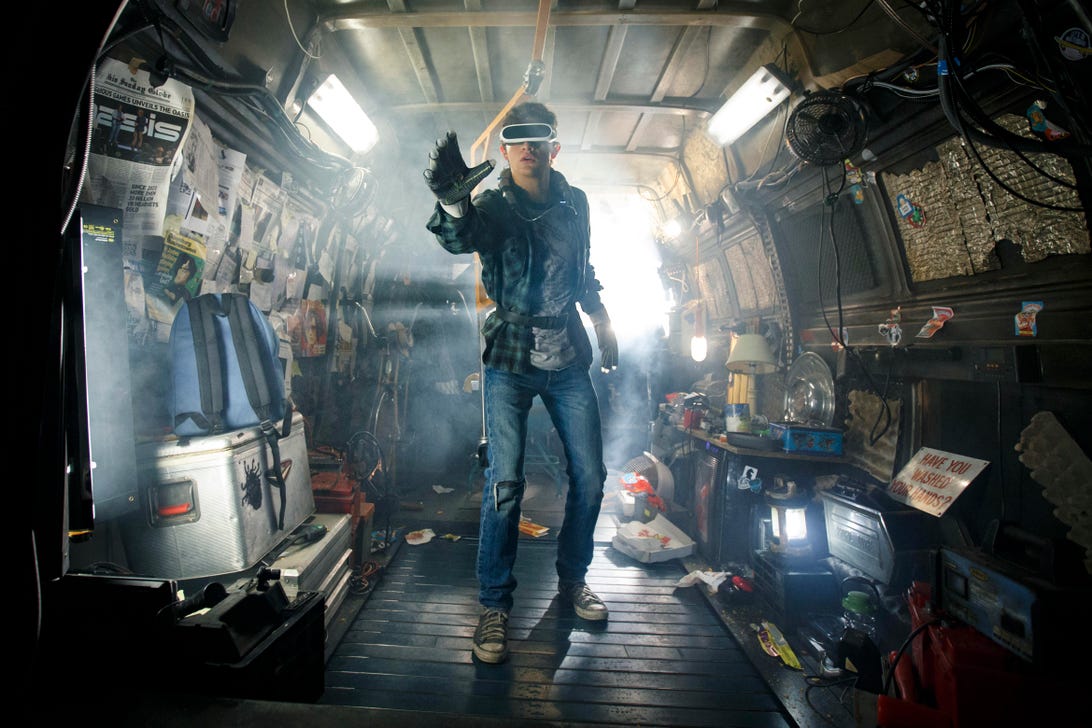
The film Ready Player One, based on a 2011 book, imagines humanity addicted to a society existing in a virtual-reality game.
Jaap Buitendijk
The Infinite wasn’t my first instance of traveling miles to try a virtual-reality adventure since the world reopened. But it was the most epic.
A massive installation that lets you explore a life-size, virtual replica of the International Space Station, The Infinite is the largest in-person VR exhibit of its kind. And as the world haltingly reopens amid COVID-19 flareups, The Infinite also comes complete with ultraviolet sterilization stations for its headsets, ridding them of germs before you lash one to your face.
Just as Netflix thrived while movie theaters imploded, the pandemic polarized virtual reality’s fortunes. VR flourished in living rooms, but lockdown and social distancing devastated in-person, location-based VR.
Yet, the recent success of The Infinite, which has toured two cities and plans to open in as many as three more before the year’s out, isn’t an anomaly. Other in-person VR businesses have reported activity near and sometimes exceeding pre-pandemic levels. These may not be the first places that come to mind when you’re hit with the hype of the Metaverse. But if you want to get a brush with how it will literally feel, location-based VR is one of the first places you should go.
The Metaverse — whatever it is now or ever shall be — is a convergence of several technologies, VR key among them. It’s not incidental that the current buzz around “the metaverse” was ignited by the owner of VR’s most popular headset, Oculus. And thanks to touch points from sci-fi imagination like Ready Player One, VR is one of the foundations to how many average folks envision the metaverse’s future consummation.
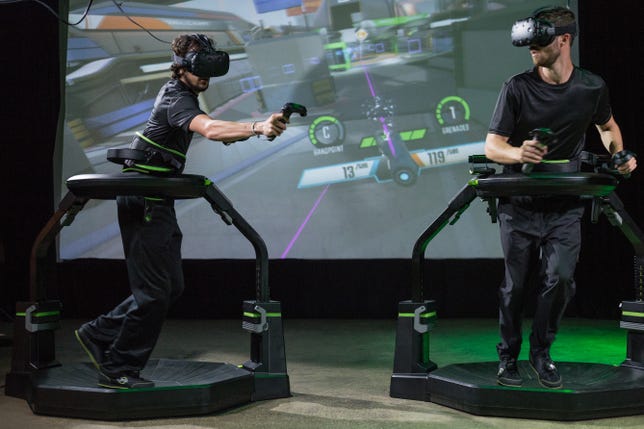
Virtuix’s Omni multidirectional treadmills hold you place while you can roam freely virtually.
Virtuix
You already can strap on a real-world likeness of Ready Player One’s fictional “haptic feedback suit,” mimicking the physical sensations of a virtual reality. And you can try a run on something like its “omnidirectional treadmill,” letting you walk to infinity without moving anywhere.
You just can’t have them at home, at least not without breaking the bank. Instead, they’re at location-based experiences.
“It’s the frontier of what’s possible,” Kent Bye, the host of the Voices of VR podcast, told me. “And location-based entertainment is always pushing the edge.”
Proving ground
Because of its limit-testing nature, location-based VR experiences differ wildly. The Infinite is one example. It can take the form of high-end VR “theaters” operated by the likes of Dreamscape or a social competition room — VR’s version of laser tag. At the other end is a VR game you might play at a Dave & Buster’s while the rest of the arcade pings and plinks in the background.
But whether it’s a “ride” at a theme park or elaborately immersive art exhibited at the Sundance Film Festival, location-based VR is virtual reality you experience outside your own home. You’re there with other people, using hardware and other architecture bespoke for that specific simulated escapade.
One advantage of building custom-tailored virtual-reality experiences is they can incorporate boundary-pushing technology that’s out of reach for a normal person.
“These location-based, immersive venues can afford to go get that technology, to give people an opportunity to test it out,” said Dan Eckert, managing director of PwC’s innovation AI and emerging technologies consultancy. Nobody is going to craft a specialized system in their home to waft heat and smoke while their virtual Star Wars skiff rides over a lava planet, he noted. But some location-based experiences can — and do.
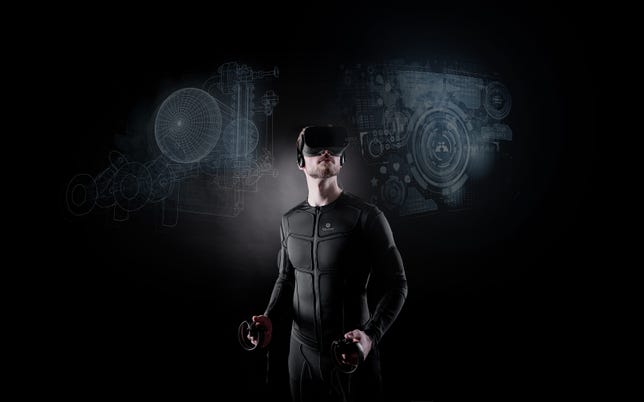
The Teslasuit is a haptic-feedback apparel that buzzes you with physical stimuli linked to a virtual world.
Teslasuit
The Teslasuit (no relation to Elon Musk) isn’t far off from Ready Player One’s imagined haptic feedback coveralls. Virtuix’s Omni multidirectional treadmills, which let you run around in VR while you stay in place, have been shipped to 500 locations worldwide, the company says.
“Location-based entertainment is a proving ground for the cutting edge of immersive technologies that are too expensive for consumers to have,” Bye said.
One of my personal favorites was a breath-measurement belt I’ve only seen once at the Tribecea Film Festival in 2016. Pointing your gaze in whatever direction you wanted to go in otherworldly underwater VR surroundings, you propel yourself forward based on how deeply you breathed. This peacefully gamified mission put me in a meditative pattern of deep breathing that calmed the prickliest edges of my nervous system and brought me to a mind-tingling zen state.
These experimental peripherals ebb and flow. Some make a foothold as VR attractions, like Virtuix with Omni, and others disappear, like my deep-breathing belt. But they still offer you the chance to encounter what the metaverse future may feel like.
“VR has come and gone in the location-based entertainment industry a few times, and each time the technology just wasn’t ready,” said Bob Cooney, a location-based entertainment industry expert who mentored companies like Virtuix and Zero Latency. By 2019, VR had won over location-based entertainment operators, leading to a spike in adoption, he said.
“And then everything just shut down.”
Filling a void
Pandemic lockdowns illuminated the appeal of at-home consumer VR, most represented now by the Oculus Quest. When we couldn’t go anywhere or be near anyone, these slightly uncomfortable boxes strapped to your face didn’t seem so silly. They offered the virtual respite to travel to far flung lands or simulate the feeling of gathering close with other people.
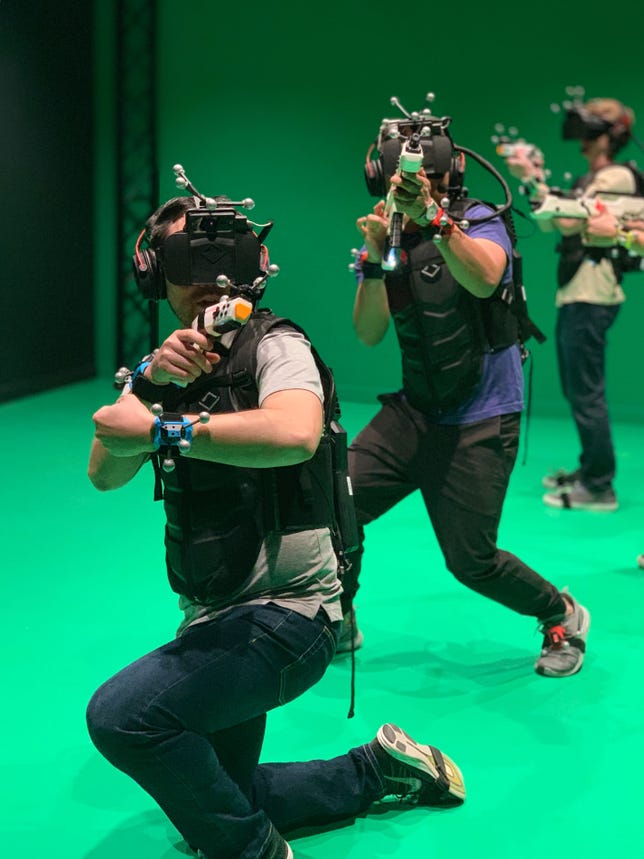
Sandbox VR filed for bankruptcy protection in the US after the pandemic hit, but it re-emerged and has reported activity beating pre-pandemic levels.
Sandbox VR
Ramon T. Llamas, a research director with IDC, estimates 1.8 million virtual-reality headsets shipped in the US pre-pandemic in 2019. Those shipments rose to 2.8 million in 2020, as pandemic-driven demand clashed with its supply-chain constraints. But in 2021, as production caught up, shipments more than doubled to 5.7 million.
But sectors of location-based VR, like all out-of-home entertainment, were devastated. Sandbox VR, a chain of 600-square-foot rooms to host six people in battling virtual zombies or visiting Star Trek planets, was backed by the likes of Justin Timberlake and Katy Perry. Its US subsidiaries filed for bankruptcy protection in August 2020. The Void, a similar venture once allied with Disney to put fans inside immersive worlds from Star Wars and Marvel blockbusters, defaulted on its loans around the same time. More than one of The Void’s landlords auctioned off its equipment as abandoned property, according to Protocol.
As the world has reopened, though, location-based VR has bounced back. Beyond experiences like The Infinite kicking off multicity tours, Sandbox VR has re-emerged from bankruptcy protection and seen ticket sales exceed pre-pandemic levels. The Void, which in a twisted joke of fate was literally rendered void by COVID, is aspiring for a comeback, having reportedly rounded up $20 million to relaunch this year.
Inevitably, technology will progress to give people refined and affordable versions of next-level immersive elements in their homes that are currently the domain of location-based experiences. But the experts I spoke with don’t anticipate the attraction for shared experiences will extinguish.
As Eckert puts it, movie theaters didn’t disappear when television was invented. A cinema’s surround sound and big screen continue to allure us, as does the social gratification of going to the movies with a pal or laughing along with the crowd in the darkness.
“In VR, that [social fulfillment] is the ‘killer app,'” Eckert said. “Yes, you can go out and go dancing by yourself. But it’s always so much better to go with your friends.” Enjoying VR — at least until presence in VR advances beyond kludgy cartoonish avatars — lines up with these same human urges for shared physical togetherness.
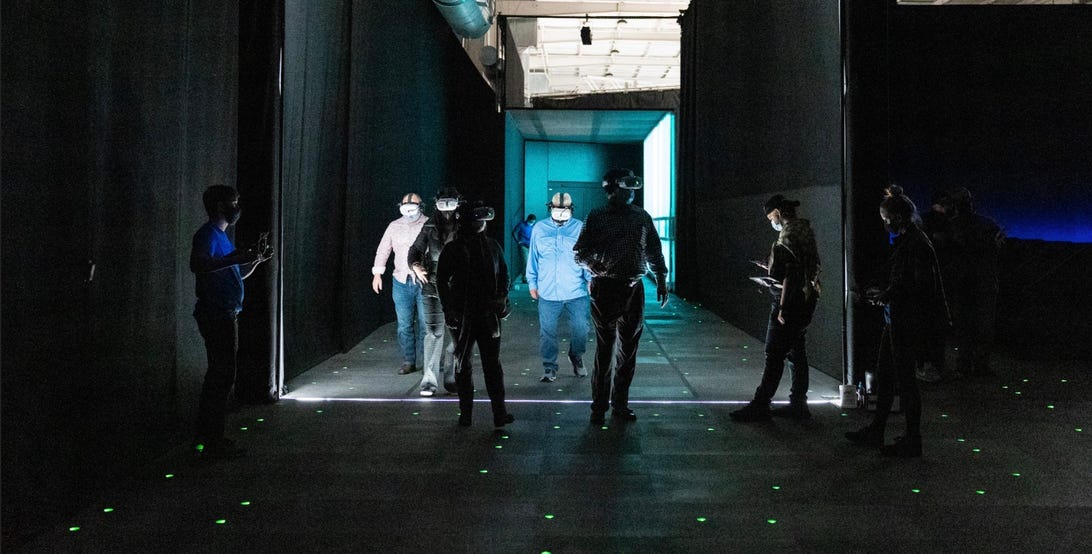
The Infinite has a room bigger than a basketball court where as many as 150 people an hour can freely roam a virtual model of the ISS.
Felix & Paul
The Infinite exists because its creators felt this urge too. When the first VR recordings from the ISS were beamed back to Earth, “we were just genuinely blown away by the emotional power of that footage,” said Félix Lajeunesse, the cofounder and creative director of Felix & Paul Studios, which spearheaded the ISS project.
The ISS footage is already an Emmy-award winning VR series called Space Explorers, but the company felt duty bound to make it available beyond just the gamers and early adopters who already had VR on hand.
With a location-based communal experience, he said, “we wanted to share it with the world.”
